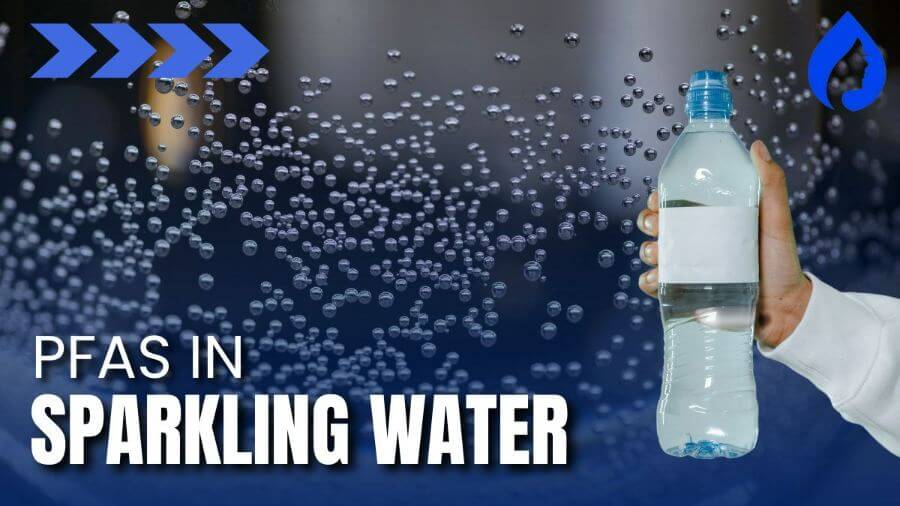
Did you know that a 2020 study conducted by Consumer Reports has revealed some alarming findings about PFAs chemicals in certain sparkling water brands?
According to the study, five popular sparkling water brands contained PFAS levels exceeding 1 ppt (parts per trillion), with Perrier Natural Sparkling Mineral Water being the highest.
It’s considered concerning based on the Environmental Working Group’s (EWG) 1 ppt standard and the Environmental Protection Agency (EPA) proposed 4 ppt (parts per trillion) limit.
Even though we know these man-made PFAS chemicals can cause serious health issues, the FDA and EPA haven’t yet regulated them in sparkling water or other drinks.
But fear not! We’re here to give you the full scoop on PFAS in sparkling water. We’ll tell you which specific brands have higher PFAS levels, so you can make informed choices about what you sip.
🍾What Brands of Sparkling Water Have PFAS in Them?
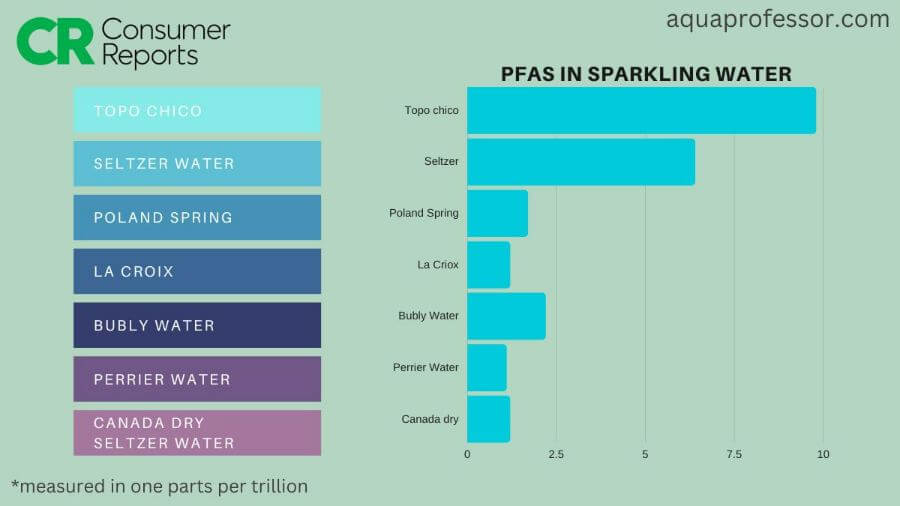
According to the 2020 Consumer Reports study, it has been revealed that five popular sparkling water brands contain PFAS levels exceeding 1 ppt (parts per trillion). These levels are deemed higher than what experts consider safe, raising concerns about the quality of the beverages we enjoy.
📈Sparkling Water High in PFAS
The specific sparkling water brands with detectable PFAS chemicals concentrations are:
In addition to PFAS, it’s worth noting that previous studies have also found the presence of BPA (Bisphenol A) in bottled water, including sparkling water brands. BPA is another chemical of concern associated with harmful effects on the brain and prostate gland.
📉Sparkling Water With the Lowest PFAS
However, there are sparkling water brands with lower or undetectable levels of PFAS, according to the same 2020 Consumer Reports study. These brands are recommended if you are worried about consuming PFAS through your beverages. These are:
Also Read: How Healthy Is Costco Water?
⚗️What Are PFAS?
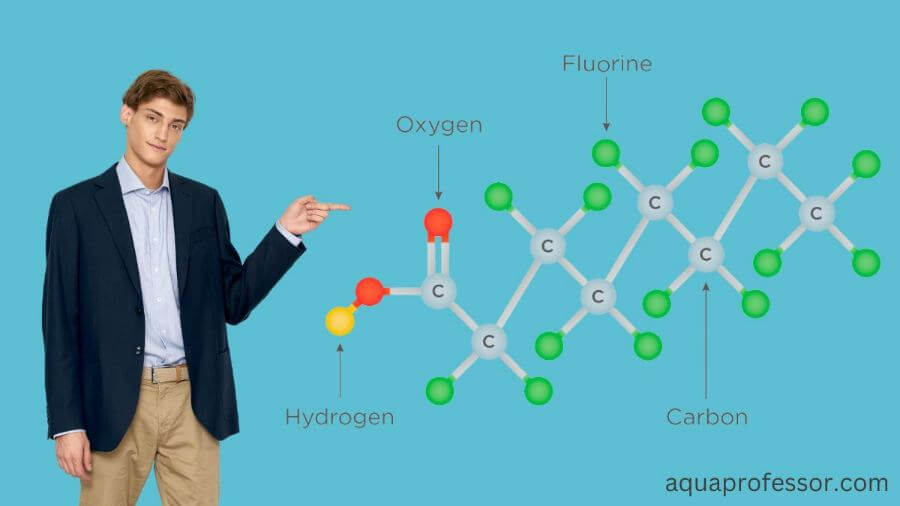
Definition:
PFAS, also known as per- and polyfluoroalkyl substances, are a group of man-made chemicals commonly referred to as “forever chemicals” due to their long-lasting nature in the environment.
These substances are composed of chemical compounds such as PFOA (perfluorooctanoic acid) and PFOS (perfluorooctanesulfonic acid) that have been widely used in consumer and industrial products for decades.
However, they were found to accumulate in human bodies and cause serious health risks, so they were voluntarily phased out of the USA Industrial scene.
PFAS can originate from everyday items like:
These sources have led to their presence in certain water sources.
The concerning aspect of these forever chemicals is that they are virtually odorless and tasteless, making it challenging to detect their presence in drinking water.
If you are worried about PFAS in your water, contact your local utility or water provider for information and specific recommendations for your community.
Also Read: Does Boiling Water Remove Minerals?
☢️Are PFAS In Drinking Water Dangerous?
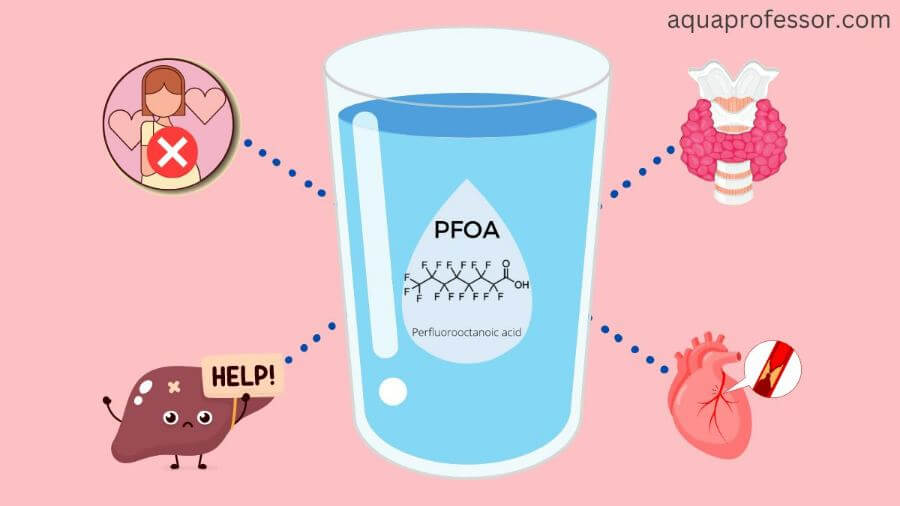
PFAS (per and polyfluoroalkyl substances) in drinking water can pose adverse health effects. Here are some of the health effects associated with exposure to high levels of PFAS in your drinking water:
- Decreased Fertility: High concentrations of PFAS have been linked to adverse effects on reproductive health, leading to reduced fertility in both men and women.
- Changes in Liver Function: PFAS exposure has been associated with liver enzymes and liver function alterations, potentially leading to liver damage and impairment.
- Developmental Issues: Pregnant women exposed to high levels of PFAS may be at risk of adverse effects on fetal development, potentially leading to birth defects or low birth weight.
- Cancer Risk: Some studies suggest a possible association between PFAS exposure and an increased risk of certain cancers, including kidney and testicular cancer.
- Increased Cholesterol Levels: Studies have linked PFAS exposure to elevated cholesterol levels in the bloodstream, which can contribute to cardiovascular problems and heart disease.
- Thyroid Disease: PFAS exposure has been linked to thyroid hormone disruption, which can lead to thyroid disease and associated symptoms such as weight changes, fatigue, and mood fluctuations.
Perfluorooctanesulfonic acid (PFOS) and perfluorooctanoic acid (PFOA) are the two PFAS chemicals that have been studied the most in relation to these health effects.
🚱Does the EPA Regulate PFAS in Drinking Water?
The EPA (Environmental Protection Agency) has proposed a limit of 4 ppt (parts per trillion) for PFAS in drinking water. However, the formal regulation process was expected to be completed by the end of 2023.
While some US states, including Alaska, Arizona, New Hampshire, and Vermont, have established their PFAS regulations, others are still developing guidelines to protect public health.
Currently, there is no legal obligation for bottled water companies to limit PFAS chemical concentrations, as the FDA (Food and Drug Administration) has delayed setting specific limits on PFAS in bottled water.
The Environmental Working Group (EWG), a non-governmental organization, has recommended a more stringent limit of 1 ppt for PFAS in drinking water to safeguard the health of children and vulnerable populations.
Also Read: Why My Tap Water Smells Like Chlorine
🍶How Does PFAS Get Into Sparkling Water?
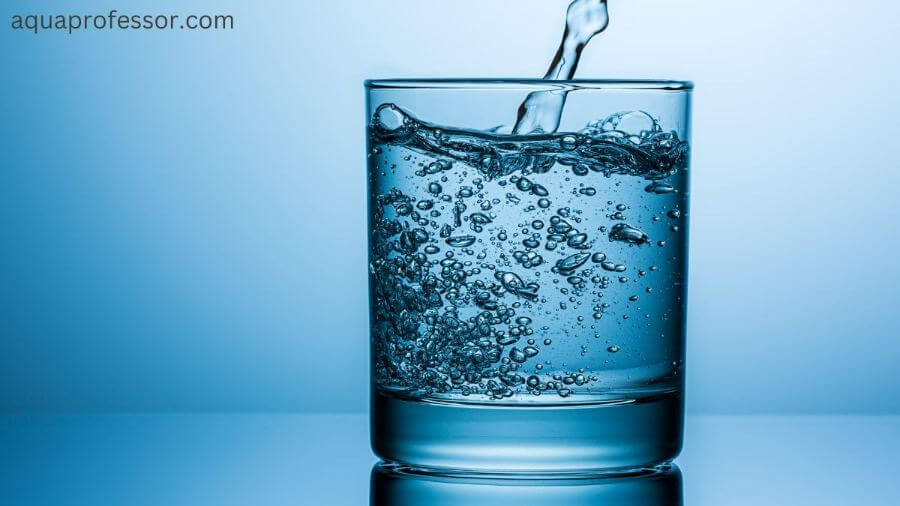
Sparkling water, often derived from natural springs, can be carbonated without undergoing extensive purification processes. Unlike tap water, which is regulated for PFAS and other contaminants, there are no legal requirements for testing or treating sparkling water sourced from natural springs.
As a result, these forever chemicals, aka PFAS, can find their way into bottled sparkling water through the following pathways:
Also Read: How Does Uranium Get In Well Water?
Considering the potential risks associated with PFAS in drinking water, consumers must be proactive in choosing safer options.
To reduce the risk of exposure to PFAS in sparkling water, here are some steps you can take:
Recent studies, such as a 2021 research published in ScienceDirect, have confirmed that spring water contains higher levels of PFAS than purified water from reverse osmosis (RO) filtration systems.
Being aware of such findings can guide us in making more health-conscious decisions when selecting our water sources.
❓PFAS In Sparkling Water: FAQs
Does all sparkling water have PFAS?
Not all sparkling waters may contain PFAS, while others may not have detectable levels of these chemicals, like the Sparkling Ice Black Raspberry Sparkling Water, which has no PFAs detected.
What is Waterloo sparkling water’s PFAS level?
Waterloo sparkling water brand claims to purify water before carbonation, which means they shouldn’t have any PFAS levels. Their purification process ensures a safer product.
What is Trader Joe’s sparkling water’s PFAS level?
Trader Joe’s bottled water has been PFAS-free since 2018. Hence their sparkling water contains no detectable levels of PFAS.
Does Kirkland sparkling water have PFAS?
As per Niagara Bottling’s 2023 reports, which produce Kirkland water, Kirkland Sparkling Water has no detectable levels of PFAS.
Does La Croix have PFAS?
According to the 2020 Consumer Reports study, La Croix detected more than 1 ppt of PFAS; to be precise, it was 1.16 ppt.
Adarsh is a Health & Nutrition Sciences graduate with expertise in environmental health. He is associated with ventures like Glacier Fresh Filter and Simpure Filter Systems. Through Aqua Professor, he intends to provide helpful information to every home to help them make smarter decisions.
